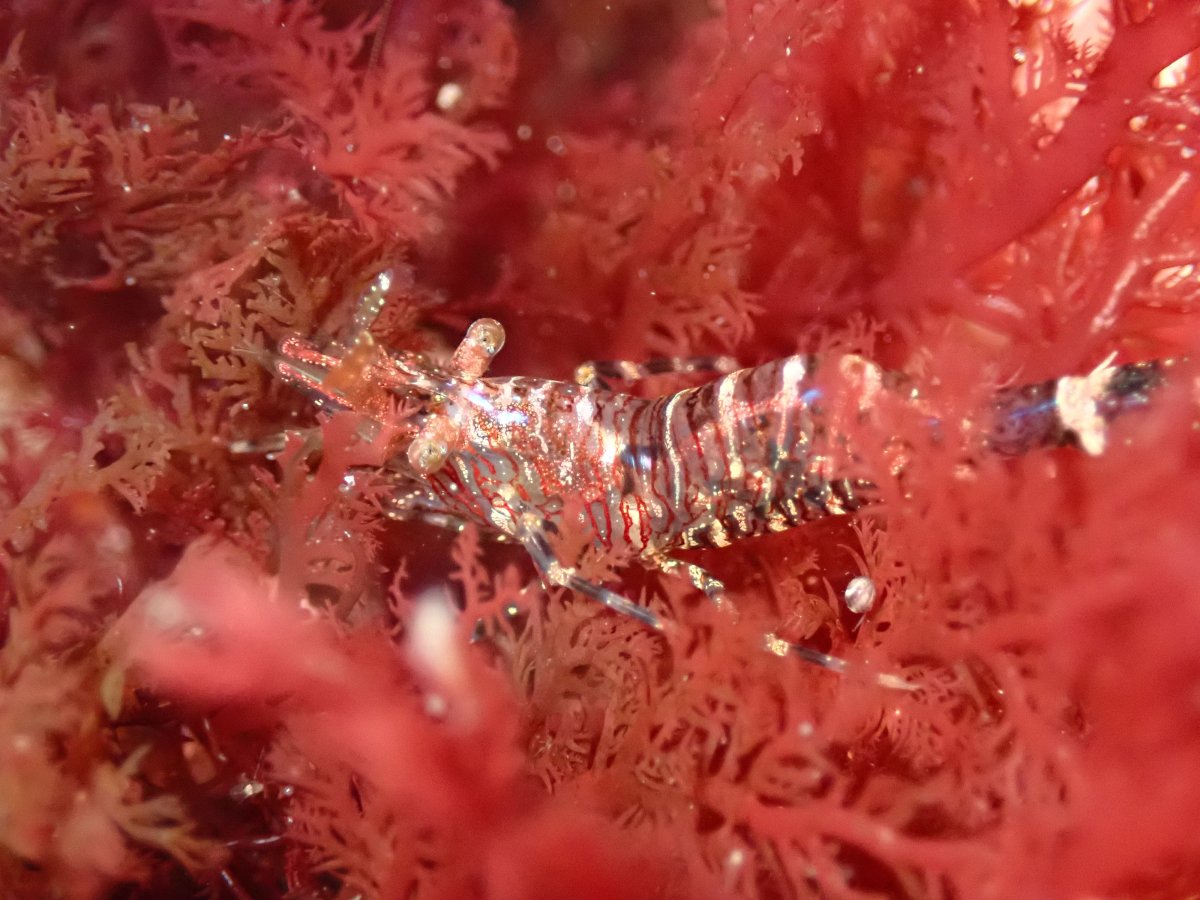Camoflauge with Bright Colors: The Red-banded transparent Shrimp

California tide pooling comes with the big and famous animals that all beachgoers want to see: anemones, sea stars, urchins, and crabs. But many other very common animals don’t get noticed, despite being all around. The red-banded transparent shrimp (Heptacarpus sitchensis) is one of them. Look closely and you’ll begin to notice these tiny, often see-through animals going about their shrimp business almost entirely unseen.
There are several species of shrimp in the genus Heptacarpus that are often found in California’s rocky intertidal, and they are very difficult to tell apart. Identification is made especially difficult by their speediness and transparency. For this reason, the photos in this article are labeled as members of this genus and not necessarily (although probably) red-banded transparent shrimp. The latter is the most common species.
Appearance

The red-banded transparent shrimp and other species in the genus (H. moseri, H. stimpsoni, and H. paludicola) are small, delicate shrimp, usually no more than an inch or two long. Most have fine red striping along their sides and legs, although bright green tails and accents of blue, purple, and black aren’t uncommon. The animal is mostly clear with its few markings and internal organs providing most of the coloration. The exoskeleton is devoid of color. The more a shrimp has eaten recently, the darker it will be as its food is visible through its body. The animal in the photo above has eaten very well recently! This genus boasts the characteristic shrimp “broken-back,” with a short tail, long, spindly legs, and stalked eyes.
Diet
Like many other intertidal scavengers, these shrimp are generalists and will eat both plant and animal matter as they come across it.
Habitat and Range

Found from pools in the mid-intertidal to a depth of about 30 ft, these shrimp are shallow water animals. They are often found under small rocks, on algae and sea grass, and on floating docks. Red-banded transparent shrimp have been reported from as far north as Alaska and as far south of Baja California, typical of northeastern Pacific species that take advantage of the relatively unchanging water temperatures in this region due to the upwelling of the California Current.
Behavior

Shrimp in the genus Heptacarpus seem to emerge on rocky shores at dusk, sometimes coming out of their hiding places in droves. They are capable of lightning-quick movement, although prefer to stay relatively still when feeding. This makes them great photo subjects if you find a brave shrimp willing to let you get close. I have found that some are more skittish than others.
Despite their bright colors, these shrimp are very well camouflaged. Or should I say because of those bright colors? Red-banded shrimp seem to stand out once you notice them, but their colors distort the outline of a shrimp against a background of algae and keep them hidden. This kind of camouflage is called color disruption, and it is used by many predators (think tigers and cheetahs) to break up their outline rather than blending perfectly into the background. It usually uses contrasting colors, like the bright lines on our shrimp. Take a look at the photo below.

What did you see first? The shrimp or the snail? Even though the shrimp is very close to the camera, it’s difficult to pick out, making use of color disruption. Look here ^(https://www.blogquicker.com/goto/https://en.wikipedia.org/wiki/Disruptive_coloration) for more info on this kind of camouflage.
You are mostly likely to first see a red-banded transparent shrimp darting away from you. I have also found that I notice them while looking closely at another animal, only to spot a shrimp right next to me. Despite their pervasiveness, they are quite beautiful if you get a chance to observe one up close. The slightly larger rockpool prawns that inhabit European waters ^(https://www.blogquicker.com/goto/https://thetideisout.com/2024/03/18/tide-pooling-log-west-coast-of-italy/) have similar camouflage methods, despite their blue and yellow markings.
#Redbanded #transparent #Shrimp #Tide



